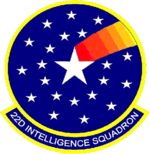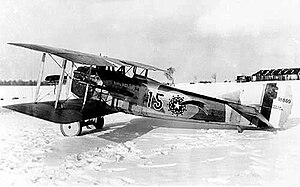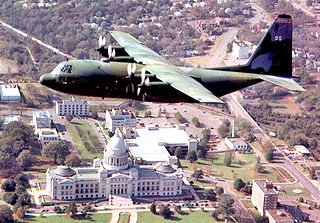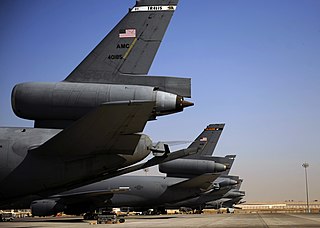| 22d Intelligence Squadron | |
|---|---|
Contents
135th Aero Squadron, November 1918, Gengault Aerodrome (Toul), France | |
| Active | 16 Jun 1917-Present |
| Country | |
| Branch | |
| Type | Squadron |
| Role | ISR |
| Part of | Air Force Intelligence, Surveillance and Reconnaissance Agency |
| Garrison/HQ | Fort George G. Meade, Maryland |
| Engagements | |
| Insignia | |
| 22d Intelligence Squadron emblem |  |
The 22d Intelligence Squadron (22 IS) is a non-flying squadron of the United States Air Force. It is assigned to the 707th Intelligence, Surveillance and Reconnaissance Group, Fort George G. Meade, Maryland.

The United States Air Force (USAF) is the aerial and space warfare service branch of the United States Armed Forces. It is one of the five branches of the United States Armed Forces, and one of the seven American uniformed services. Initially formed as a part of the United States Army on 1 August 1907, the USAF was established as a separate branch of the U.S. Armed Forces on 18 September 1947 with the passing of the National Security Act of 1947. It is the youngest branch of the U.S. Armed Forces, and the fourth in order of precedence. The USAF is the largest and most technologically advanced air force in the world. The Air Force articulates its core missions as air and space superiority, global integrated intelligence, surveillance, and reconnaissance, rapid global mobility, global strike, and command and control.

The 707th Intelligence, Surveillance and Reconnaissance Group is a unit of the United States Air Force 70th Intelligence, Surveillance and Reconnaissance Wing located at Fort George G. Meade, Maryland.

Fort George G. Meade is a United States Army installation located in Maryland, that includes the Defense Information School, the Defense Media Activity, the United States Army Field Band, and the headquarters of United States Cyber Command, the National Security Agency, the Defense Courier Service, Defense Information Systems Agency headquarters and the U.S. Navy's Cryptologic Warfare Group Six. It is named for George G. Meade, a general from the U.S. Civil War, who served as commander of the Army of the Potomac. The fort's smaller census-designated place includes support facilities such as schools, housing, and the offices of the Military Intelligence Civilian Excepted Career Program (MICECP).
The 22 IS is one of the oldest units in the United States Air Force, its lineage and history consisting of two World War I Western Front combat squadrons.

World War I, also known as the First World War or the Great War, was a global war originating in Europe that lasted from 28 July 1914 to 11 November 1918. Contemporaneously described as "the war to end all wars", it led to the mobilisation of more than 70 million military personnel, including 60 million Europeans, making it one of the largest wars in history. It is also one of the deadliest conflicts in history, with an estimated nine million combatants and seven million civilian deaths as a direct result of the war, while resulting genocides and the 1918 influenza pandemic caused another 50 to 100 million deaths worldwide.

The Western Front was the main theatre of war during the First World War. Following the outbreak of war in August 1914, the German Army opened the Western Front by invading Luxembourg and Belgium, then gaining military control of important industrial regions in France. The tide of the advance was dramatically turned with the Battle of the Marne. Following the Race to the Sea, both sides dug in along a meandering line of fortified trenches, stretching from the North Sea to the Swiss frontier with France, which changed little except during early 1917 and in 1918.
- The 22d Aero Squadron was organized on 16 June 1917 at Kelly Field, Texas. A Pursuit (Fighter) squadron of the American Expeditionary Forces, it took part in the Somme Defensive; St. Mihiel offensive, and Meuse-Argonne offensive campaigns. The unit was demobilized after the war in 1919.
- The 135th Aero Squadron was organized on 1 August 1917 at Rockwell Field, California. A Corps Observation (Reconnaissance) squadron, it took part in the Somme Defensive; St. Mihiel offensive, and Meuse-Argonne offensive campaigns. It was re-designated as the 22d Observation Squadron in March 1921 as part of the permanent United States Army Air Service. [1] [2]

Rockwell Field is a former United States Army Air Corps military airfield, located 1.1 miles (1.8 km) northwest of the city of Coronado, California on the northern part of the Coronado Peninsula across the bay from San Diego, California.
The two units were consolidated in April 1937. During World War II, the squadron became part of Ninth Air Force in the European Theater of Operations (ETO) as a tactical reconnaissance squadron. During the Cold War, it was part of Tactical Air Command. [2] [3]

World War II, also known as the Second World War, was a global war that lasted from 1939 to 1945. The vast majority of the world's countries—including all the great powers—eventually formed two opposing military alliances: the Allies and the Axis. A state of total war emerged, directly involving more than 100 million people from over 30 countries. The major participants threw their entire economic, industrial, and scientific capabilities behind the war effort, blurring the distinction between civilian and military resources. World War II was the deadliest conflict in human history, marked by 50 to 85 million fatalities, most of whom were civilians in the Soviet Union and China. It included massacres, the genocide of the Holocaust, strategic bombing, premeditated death from starvation and disease, and the only use of nuclear weapons in war.

The Ninth Air Force is a numbered air force of the United States Air Force's Air Combat Command (ACC). It has been headquartered at Shaw Air Force Base, South Carolina, since activation on 5 August 2009. From 1990, units were deployed to the Middle East against Iraq, and from 2001 against threats emanating from Afghanistan. This prior Ninth Air Force is now known as United States Air Forces Central (USAFCENT).

The Cold War was a period of geopolitical tension between the Soviet Union with its satellite states, and the United States with its allies after World War II. A common historiography of the conflict begins with 1946, the year U.S. diplomat George F. Kennan's "Long Telegram" from Moscow cemented a U.S. foreign policy of containment of Soviet expansionism threatening strategically vital regions, and ending between the Revolutions of 1989 and the 1991 collapse of the USSR, which ended communism in Eastern Europe. The term "cold" is used because there was no large-scale fighting directly between the two sides, but they each supported major regional conflicts known as proxy wars.

























